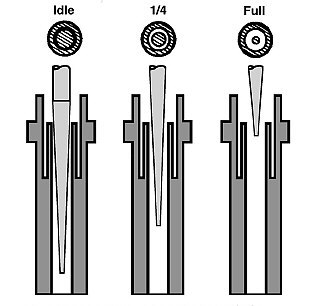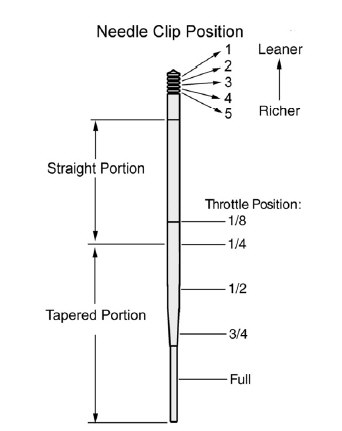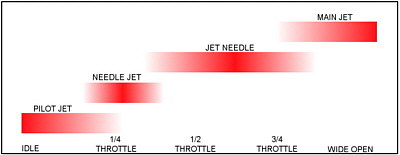Carburetor Jetting - the theory
Carburetor jetting controls the fuel air mixture fed to the engine. When the throttle is closed, just enough gas and air are fed to the engine to keep it idling at around 1500rpm. The gas:air ratio has to be correct or the bike won't idle properly. Perfect stoichiometry (i.e. the condition under which there is exactly the right amount of air to burn all the fuel) is a air:fuel ratio of around 14.7:1. If there's not enough fuel and too much air, the mixture is said to be LEAN, while if there is too much fuel and not enough air the mixture is said to be RICH. Stoichiometric mixtures are normally used under light load cruising conditions. When we talk about performance problems being due to a mixture that is lean or rich, what we're really talking about is a mixture that is either too lean or too rich since we often want a mixture that is not the 14.7:1 stoichiometric ratio for various reasons such as preventing pre-detonation ("pinging"), maximizing power or reducing combustion temperature.
To get the right mixture at any given throttle opening, various jets within the carburetor supply fuel at a rate related to the throttle opening. Of course we have to define "right mixture". In fact you need a different air/fuel ratio for minimum emissions than you do for maximum power, and yet again a different ratio for the best mpg numbers. You also need different jet settings with a stock bike then if you fit a free flowing exhaust and/or a better breathing air filter.
Manufacturers often use jets which give the lowest emissions and best mpg for stock bikes, which means they tend to run a little lean. Low emissions are required for the bike to be EPA certified. However riders may want maximum power or smoothest running and that might dictate the need of different jets. Maximum power is obtained when running slightly rich. Be aware though that there are regulations prohibiting tampering with carburetor jets for on road use since it will affect emissions. In fact some companies will not sell jetting kits in California due to state regulations and most bikes come from the factory with sealed pilot jets to prevent owners from adjusting the settings.
So what are the jets and how do they do what do they do?
There are four basic jets in the Ninja 250 carburetors.
- The pilot jet. This supplies fuel when the bike is idling and contributes to the fuel whenever you are using up to about 25% open throttle. The flow is adjustable (if you remove any devices installed by the manufacturer to stop you adjusting it) via a mixture screw. When the screw is turned fully in, the fuel flow is cut off. On the stock Ninja 250 the screw needs to be opened up by about 2 turns. If you have an aftermarket exhaust and air filters it may need to be opened up to 3 turns to allow more fuel to flow.
-
The second and third jet system which mainly operates when the throttle is from 1/4 open to 3/4 open is the needle jet and the jet needle. The needle jet is a small circular tube and the jet needle is a tapered metal rod which fits into the opening.

When the needle is fully in the jet, fuel flow is blocked off, when it is raised so that a smaller section is within the opening, more fuel flows. Opening the throttle raises the jet needle, allowing more fuel to flow. At first the fuel flow is limited by the diameter of the needle jet, but as the throttle is opened more, the tapered needle is pulled out of the jet allowing more fuel to flow. You can alter the amount of fuel flowing at any given throttle opening by raising the default height of the jet needle or by using a different jet needle with a different taper profile. The image below shows a needle with various positions for a clip ring which changes the height of the needle. The stock Ninja 250 carb needles don't have a clip system. To raise the needles you need to add washers under the fixed position stop.
- Finally the main jet controls the fuel flow form 3/4 throttle to wide open throttle. The main jet actually feeds through the needle jet, so when the needle jet is closed, the main jet is also closed. When the needle jet is fully open, the main jet is what limits the fuel flow. The amount of fuel flowing at WOT (wide open throttle) can be changed by changing the main jet. Jets with a larger hole flow more fuel.
This is summarized in the diagram below:

So you can adjust the fuel flow and fuel/air mixture by the following actions:
- At low throttle openings you can adjust the mixture screw which changes the flow through the pilot jets.
- At mid range throttle openings you can adjust the needle height and jet needle profile. You could change the size of the needle jet, though this isn't normally done on the Ninja 250
- At wide throttle openings you can change the size of the main jet.
It's important to note though that the three ranges overlap, so the mixture screw setting affects the mid range somewhat, even though the needle jet and jet needle have a larger effect. Similarly the main jet affects the mid range somewhat, as well as wide open throttle performance. So getting everything optimized can be something of an art, as well as a science.